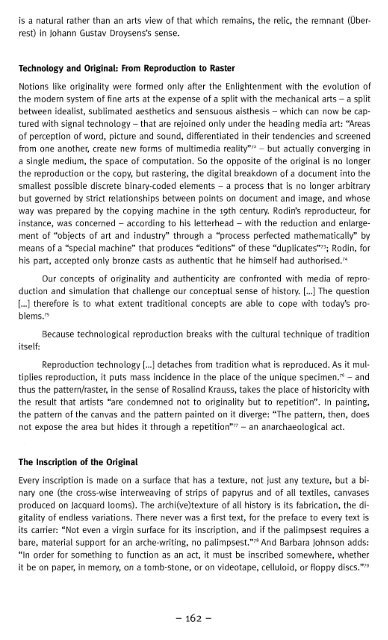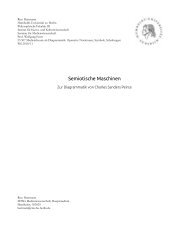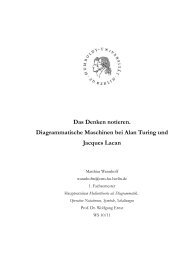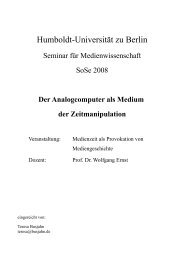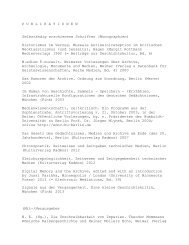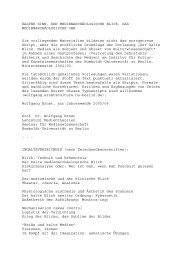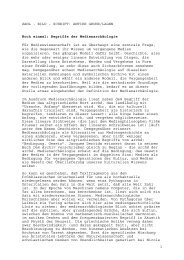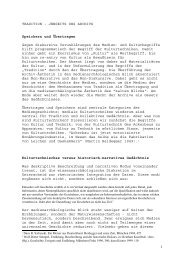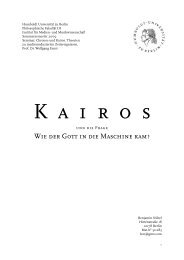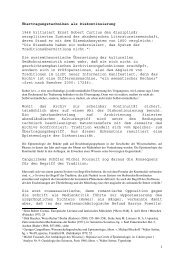Download - Medienwissenschaft
Download - Medienwissenschaft
Download - Medienwissenschaft
Create successful ePaper yourself
Turn your PDF publications into a flip-book with our unique Google optimized e-Paper software.
is a natural rather than an arts view of that which remains, the relic, the remnant (Überrest)<br />
in Johann Gustav Droysens's sense.<br />
Technology and Original: From Reproduction to Raster<br />
Notions like originality were formed only after the Enlightenment with the evolution of<br />
the modern system of fine arts at the expense of a split with the mechanical arts - a split<br />
between idealist, sublimated aesthetics and sensuous aisthesis - which can now be captured<br />
with signal technology - that are rejoined only under the heading media art: "Areas<br />
of perception of word, picture and sound, differentiated in their tendencies and screened<br />
from one another, create new forms of multimedia reality" 72 - but actually converging in<br />
a single medium, the space of computation. So the opposite of the original is no longer<br />
the reproduction or the copy, but rastering, the digital breakdown of a document into the<br />
smallest possible discrete binary-coded elements - a process that is no longer arbitrary<br />
but governed by strict relationships between points on document and image, and whose<br />
way was prepared by the copying machine in the 19th century. Rodin's reproducteur, for<br />
instance, was concerned - according to his letterhead - with the reduction and enlargement<br />
of "objects of art and industry" through a "process perfected mathematically" by<br />
means of a "special machine" that produces "editions" of these "duplicates" 73 ; Rodin, for<br />
his part, accepted only bronze casts as authentic that he himself had authorised. 74<br />
Our concepts of originality and authenticity are confronted with media of reproduction<br />
and simulation that challenge our conceptual sense of history. [...] The question<br />
[...] therefore is to what extent traditional concepts are able to cope with today's problems.<br />
75<br />
Because technological reproduction breaks with the cultural technique of tradition<br />
itself:<br />
Reproduction technology [...] detaches from tradition what is reproduced. As it multiplies<br />
reproduction, it puts mass incidence in the place of the unique specimen. 76 - and<br />
thus the pattern/raster, in the sense of Rosalind Krauss, takes the place of historicity with<br />
the result that artists "are condemned not to originality but to repetition". In painting,<br />
the pattern of the canvas and the pattern painted on it diverge: "The pattern, then, does<br />
not expose the area but hides it through a repetition" 77 - an anarchaeological act.<br />
The Inscription of the Original<br />
Every inscription is made on a surface that has a texture, not just any texture, but a binary<br />
one (the cross-wise interweaving of strips of papyrus and of all textiles, canvases<br />
produced on Jacquard looms). The archi(ve)texture of all history is its fabrication, the digitality<br />
of endless variations. There never was a first text, for the preface to every text is<br />
its carrier: "Not even a virgin surface for its inscription, and if the palimpsest requires a<br />
bare, material support for an arche-writing, no palimpsest." 78 And Barbara Johnson adds:<br />
"In order for something to function as an act, it must be inscribed somewhere, whether<br />
it be on paper, in memory, on a tomb-stone, or on videotape, celluloid, or floppy discs." 79<br />
- 162 -


